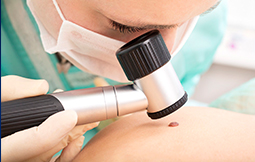
Skin cancer happens when there is an uncontrollable growth of abnormal skin cells. These cells are originated from the cells of the epidermis, the superficial layer of the skin.
Skin cancer happens when there is an uncontrollable growth of abnormal skin cells. These cells are originated from the cells of the epidermis, the superficial layer of the skin. It takes place when unrepaired DNA damage to skin cells triggers mutations, or genetic defects, that lead the skin cells to multiply rapidly and form malignant tumors. The vast majority of these sorts of skin cancers rarely spread to other parts of the body and become life-threatening.
Mr. Frederick Mohs discovered Mohs Surgery in the 1930s which is one of the most common solutions to treat skin cancer. Today, it is one of the most effective techniques for basal cell carcinoma treatment and squamous cell carcinoma treatment – the two most common skin cancer types.
In this procedure, cancerous cells that are found in the skin are removed from the skin layer by layer until the removed layers show no sign of cancer cells. Mohs surgery is most often used on more visible areas, such as the head and neck or hands, to limit scarring and ensures minimal damage to healthy skin cells around the affected areas. It is possible to achieve cancer-free margins with this technique and thus, it is considered an effective treatment for recurrent skin cancers.
Skin usually develops in areas of your body that get the greatest exposure to the sun’s ultraviolet (UV) rays. Most skin cancers are found on areas of the body exposed to the sun for most of the time. If you notice any difference in the color of your skin or texture for a long time, An unusual skin growth or sore that doesn’t go away may be the first indication of non-melanoma skin cancer. At first Skin cancer may just appear as a nodule, rash, or irregular patch on the surface of the skin. If you see any of these symptoms it might be best to visit a skin specialist before it is too late
Mohs surgery is the best treatment for skin cancer as it is known to treat many types of cancers and minimize reoccurrence as well. This surgery is recommended in the following cases:
There are a number of important precautions and positive steps before Mohs surgery is performed. It is always important to notify your doctor beforehand if you are on any blood-thinning medication, or else it can result in excessive bleeding during your surgery. You will be advised to avoid alcohol and smoking at least 2-3 days before your surgery as it can severely affect the outcome of the surgery. You will be asked to wear loose clothing in the affected area during your surgery. You should also avoid any kind of make-up or lotion if the surgery is on your face. You will also be given certain instructions and some medications that must be taken before the procedure by your doctor.
The Mohs procedure is performed by a surgeon with special training. It is performed under an injected local anesthesia that is given as an outpatient procedure. Surgeons numb your skin so that you don’t feel the pain of the surgery. The surgery lasts from 4 to 6 hours, based on the size of the tumor. Then the surgeon will mark the affected area and sterilize it. The surgeon then starts removing a very thin layer of the skin (including the tumor) and then checks the removed sample under a microscope and If cancer cells are seen, another layer is removed and examined. One by one, tissue layers are removed until the skin samples are free of cancer cells and the doctor finds a layer of healthy tissue without any sign of cancer. This is a slow process, often taking several hours, but it only means that more normal skin near the tumor can be saved. Thus, in this surgery, only the affected tissues are removed and healthy tissue is spared. At last, the surgeon will close the wound with stitches. Normally, It takes a few days to get them repair.
After Mohs surgery procedure, most patients find the recovery process simple and easy. This surgery leaves you with minimal pain. But there are few precautions that are advised by the doctor that includes avoiding any strenuous activity for at least a week post the operation. If the patient notices increased tenderness for many days, fever, or yellow drainage from the wound, they should contact their surgeon immediately. A patient may require a reconstructive repair of the wound If the tumor was large and aggressive. Post-surgery your surgeon arranges a schedule of post-surgical checkups that may extend many years into the future. The recovery time in Mohs surgery largely depends on the size of the tumor and its location on the body.
Though there are fewer risks involved in skin cancer treatment, there are still some complications that may occur during or after the procedure. Before you make any decision you must carefully analyze the risk factors that are associated with the surgery. Some of these complications include:
Copyright © 2025 IMA | All Rights Reserved.